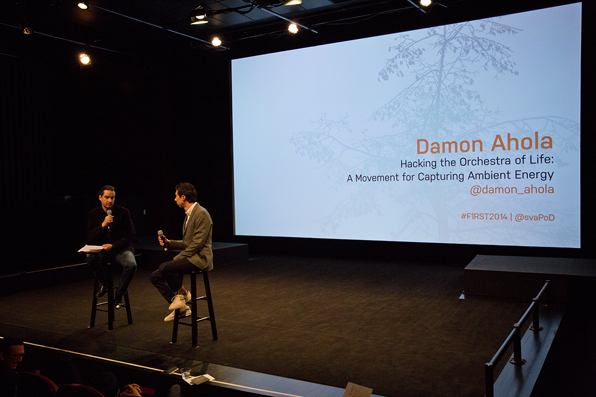Masters Thesis: Hacking the Orchestra of Life: A Movement for Capturing Ambient Energy, by Damon Ahola
Products of Design MFA student Damon Ahola’s thesis, entitled “Hacking the Orchestra of Life: A Movement for Capturing Ambient Energy,” explores the space of energy generation through human-made sources. While jogging on a treadmill at the gym one day, Damon looked at the landscape of people bobbing up and down on machines. He thought, “We were all exerting a huge amount of energy, but consuming a vast amount of energy as well.” His observation led to the question, “how can we take advantage of all of this activity?”
Ahola also looked ahead to population growth. The United Nations estimates that by 2050, the number of people in the world will increase from 7.1 billion to 9.6 billion, necessitating a need for 50% more energy. Inspired by the notion that “everything that lives also moves,” Damon used this ideal to frame his year-long body of work, aiming to inspire meaningful change by challenging people’s perception of energy use and production.
Damon began by investigating the small but growing landscape of existing energy harvesting products, both real and speculative. Through ideation drawings, four distinct areas began to emerge: tools, transportation, human movement, and animal movement. Damon investigated activities requiring micro movements—such as chewing gum, to macro movements—such as harvesting the massive power of a jet engine. (He even imagined a speculative New York City catch-and-release rat program, where rats with embedded, kinetic-powered Wi-Fi transmitters provide internet access to subway riders.)
He then took to observing and documenting human behaviors, and particularly the ways in which people move. He designed a set of speculative energy stones, carried in pockets and backpacks, capturing and storing converted kinetic energy to internal batteries. After moving all day, users empty their pockets, placing the stones in a tray that then inductively charges their electronic devices. Looking at emerging trends around wearable technology, Damon designed a conceptual watch that harvests kinetic energy and stores it to a modular system of stacked removable batteries. Damon also created a quick concept video, entitled “Hacked Couture,” portraying a city dweller in the year 2018 where energy harvesters, sewn directly into his clothing, ultimately power household objects such as small lamps when the user hangs up their clothes at the end of the day.
In-depth research around physics, electricity and batteries led Damon to a technical paper entitled, “Movers and Shakers: Kinetic Energy Harvesting for the Internet of Things.” The paper was coauthored by John Kymissis, an electrical engineering professor at Columbia University (and who ultimately became Damon’s off-campus thesis advisor). In the paper, researchers placed accelerometers in the shirt pockets of 40 participants, each running for 20 seconds. The energy generated through the participants’ movement resulted in a median reading of 813 microwatts—or about 0.0000407 of a Joule. The study illustrated that it would take 16.5 minutes of jogging to power an LED for a disappointing 10 seconds only.
Using this rating as a benchmark, Damon decided to build a quick energy harvester for himself—but this time through electromagnetism—attaching components of a shake flashlight to the sides of his running shoes. He was able to produce approximately 0.05 of a Joule through his movement. Here, Damon calculated that he would have to walk almost 200 miles in order to charge his mobile phone, and a lengthy 3,100 miles to fully charge his laptop battery. Balancing the fact that the energy volumes generated from human movement with current technology are quite dismal, Damon took inspiration from a provocation during his interview with Cameron Tonkinwise, Director of Design Studies at Carnegie Mellon. Tonkinwise stated, “Little bits add up to a lot.” Using this notion as a springboard, Damon committed himself to creating a system that would leverage the power of numbers: Looking at the opportunity on a macro, global scale with billions of people harvesting power from constant movement and activity, he envisioned a product, platform, and system called “Harvest.”
Harvest transforms a user’s daily movement into quantifiable energy. Using an electromagnetic process, energy is stored to a micro rechargeable lithium-ion battery called a “pod,” which is embedded in footwear, apparel and bicycles. The energy is stored to the Harvest pod battery, and users can check their progress and metrics using the Harvest app. Harvest—supplying the energy harvesting technology—partners with footwear, apparel and bicycle companies such as Nike, Lululemon and Trek. Harvest users become members of the platform, uploading their energy by visiting “Harvest Hotspots” such as Nike and Lululemon stores, as well as Whole Foods, Starbucks and other likeminded, progressive organizations.
Harvest Hotspots utilize the existing infrastructure of the Square point-of-sale kiosk system, and the harvested energy is transferred and stored to a green energy bank. Once enough energy is accumulated, a Renewable Energy Certificate is created. The certificate is then sold on the energy market, and the proceeds are donated to a set of philanthropic and charity organizations such as The American Red Cross and 1% for the Planet.
To gain awareness, Damon imaged a campaign featuring Nike-sponsored athletes, posing the question, “What would you do with the energy of LeBron James?” Here, “celebrity energy” would capture the imagination of potential users, raising visibility, pushing adoption rates, and promoting both Harvest and the co-branded organization.
Damon found a number of other promising sources for energy harvesting—beyond shoes and clothing. Embracing a more experimental, hacking side of Harvest, product concepts and working prototypes fell under the brand of Harvest Lab. Here, he explored “moving objects” within the urban environment, reframing the rotating wheels of taxis as both a literal and figurative “vehicles for capture energy.” Building a working prototype titled TaxiHack, Damon was able to receive a small charge to his cell phone battery by attaching the prototype energy harvester to a car wheel that traveled only six blocks. Here, the idea of “energy pirating” became very intriguing, where one can envision a world where Harvest users attach their pods to all manner of moving objects—school buses with regular routes, shopping carts with predictable nesting stations, revolving doors in public buildings—and then remove them at the end of the day when they’re all charged up.
Another Harvest Lab experiment is “Project ZipLight.” Through research and prototyping, Damon found that a DC motor is one of the most efficient methods for harvesting energy. By directly connecting an LED to a DC motor and running the device down a zip line to generate energy, he circumvented the need for a capacitor or a battery to power the light.
Project ZipLight was inspired by the Gravity Light designed by London-based company Deciwatt. Gravity Light generates energy to power an LED simply by taking advantage of potential energy and gravity. The user first raises a heavy bag of sand. The lowering of the bag transforms mechanical energy into electrical energy, illuminating an LED. Project ZipLight replaces the need for a lowering weight with a horizontal, tilted zip line. A rig consisting of cords, pulleys, and LED lights was deployed and tested in Brooklyn’s Prospect Park. By framing the experiment as a public performance, a technical system that utilizes weight and gravity to transfer mechanical energy into electrical energy was transformed into a delightful and curious spectacle, prompting people to ponder the possibilities around novel, unique methods for energy capture and generation.
In a final conceptual exercise, Damon diagrammed three speculative worlds set in the early 2050s, using them as settings for thought experiments that would probe the possible benefits and con- sequences of harvesting ambient energy.
The third narrative, “The Suit,” is set in 2054, in a world in which citizens are mandated to generate a certain amount of energy through wearing an energy-harvesting suit. The story takes place over a day in the life of the protagonist, Anders, as he goes to work and interacts with his suit. In the end, he discovers a way to escape from the suit. Damon used “The Suit” as inspiration for creating a physical object. The object, which is meant to demonstrate speculative principles, consists of an articulating structure that locks onto a subject’s arm. In the fully realized version of the project, energy will be harvested and stored throughout the day as the wearer moves and flexes their arm.
Through product design, interaction design, service design, branding and platforms, Harvest instantiates the notion that anything that moves can be seen as—and converted into—a source for energy. There is an immediate, urgent need for new green energy, and it is possible to realize meaningful change by using design to reframe our perception of energy use and production.
View more of Damon Ahola’s work at damonahola.com or email him at damon[at]damonahola[dot]com.






















